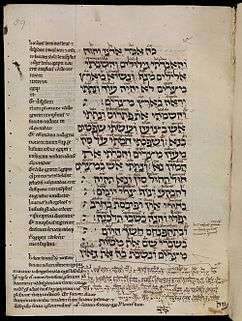Ezekiel 10
| Ezekiel 10 | |
|---|---|
 Book of Ezekiel 30:13–18 in an English manuscript from the early 13th century, MS. Bodl. Or. 62, fol. 59a. A Latin translation appears in the margins with further interlineations above the Hebrew. | |
| Book | Book of Ezekiel |
| Bible part | Old Testament |
| Order in the Bible part | 26 |
| Category | Nevi'im |
Ezekiel 10 is the tenth chapter of the Book of Ezekiel in the Hebrew Bible or the Old Testament of the Christian Bible. This book contains the prophecies spoken by the prophet Ezekiel, and is one of the Books of the Prophets.[1][2]
Text
- The original text is written in Hebrew language.
- This chapter is divided into 22 verses.
Textual versions
Some most ancient manuscripts containing this chapter in Hebrew language:
- Masoretic Text (10th century)
- Dead Sea Scrolls: (2nd century BC)[3][4]
- 4Q73 (4QEzeka): extant verses 5-22
Ancient translations in Koine Greek:
- Septuagint (3rd century BC)
- Theodotion version (~AD 180)
Verse 4
- Then the glory of the Lord went up from the cherub,
- and stood over the threshold of the house;
- and the house was filled with the cloud,
- and the court was full of the brightness of the Lord's glory.[5]
Verse 15
- And the cherubims were lifted up.
- This is the living creature that I saw by the river of Chebar.[9]
- "Cherub": see notes on Ezekiel 10:4.
Verse 20
- This is the living creature that I saw under the God of Israel by the river of Chebar;
- ' and I knew that they were the cherubims.[10]
- "Living creature": see notes on Ezekiel 10:15.
Verse 22
- And the likeness of their faces was the same as the faces which I had seen by the River Chebar,
- their appearance and their persons.
- They each went straight forward. (NKJV)[11]
See also
|
|
|
- Related Bible parts: Deuteronomy 31, Ezekiel 1, Hosea 9, 1 Corinthians 14, Hebrews 1, Revelation 2
Notes and references
- ↑ J. D. Davis. 1960. A Dictionary of the Bible. Grand Rapids, Michigan: Baker Book House.
- ↑ Theodore Hiebert, et al. 1996. The New Interpreter's Bible: Volume VI. Nashville: Abingdon.
- ↑ Timothy A. J. Jull; Douglas J. Donahue; Magen Broshi; Emanuel Tov (1995). "Radiocarbon Dating of Scrolls and Linen Fragments from the Judean Desert". Radiocarbon. 38 (1): 14. Retrieved 26 November 2014.
- ↑ Ulrich 2010, p. 587.
- ↑ Ezekiel 10:4
- ↑ Brown, Francis; Briggs, Charles A.; Driver, S. R. The Brown-Driver-Briggs Hebrew and English Lexicon. Hendrickson Publishers; Reprint edition (1994). ISBN 978-1565632066. "כְּרוּב".
- ↑ Gesenius, H. W. F. Gesenius' Hebrew and Chaldee Lexicon to the Old Testament Scriptures: Numerically Coded to Strong's Exhaustive Concordance, with an English Index. Samuel Prideaux Tregelles (Translator). Baker Book House; 7th edition. 1979. כְּרוּב
- ↑ The New Oxford Annotated Bible with the Apocrypha, Augmented Third Edition, New Revised Standard Version, Indexed. Michael D. Coogan, Marc Brettler, Carol A. Newsom, Editors. Publisher: Oxford University Press, USA; 2007. pp. 1192-1193 Hebrew Bible. ISBN 978-0195288810
- ↑ Ezekiel 10:15
- ↑ Ezekiel 10:20
- ↑ Ezekiel 10:22
- ↑ Allen, Leslie C. (1994). Word Bible Commentary: Ezekiel 1–19. Dallas: Word, Incorporated. p. 22. ISBN 0-8499-0830-2.
- ↑ Block, Daniel I. (1997). NICOT: The Book of Ezekiel: Chapters 1–24. Grand Rapids, Michigan: Eerdmans. p. 84. ISBN 0802825354.
Bibliography
- Bromiley, Geoffrey W. (1995). International Standard Bible Encyclopedia: vol. iv, Q-Z. Eerdmans.
- Clements, Ronald E (1996). Ezekiel. Westminster John Knox Press. ISBN 9780664252724.
- Joyce, Paul M. (2009). Ezekiel: A Commentary. Continuum. ISBN 9780567483614.
- Ulrich, Eugene, ed. (2010). The Biblical Qumran Scrolls: Transcriptions and Textual Variants. Brill.
External links
Jewish
Christian
This article is issued from
Wikipedia.
The text is licensed under Creative Commons - Attribution - Sharealike.
Additional terms may apply for the media files.